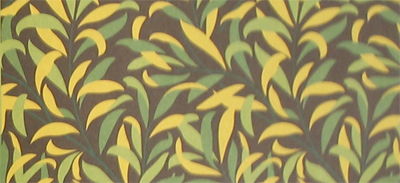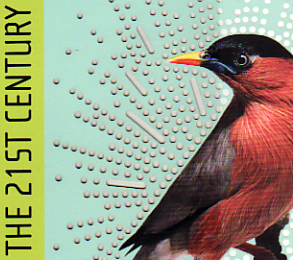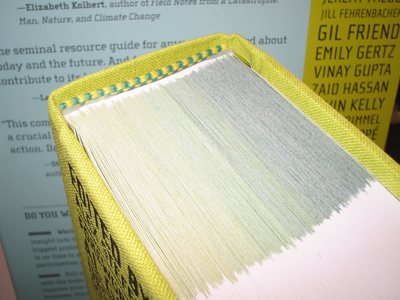“I did not do this on purpose.” These were unlikely words to hear from Stefan Sagmeister, though he spoke them over his bashful child-like laughter. We were to discuss the recently published Worldchanging: A User’s Guide to the 21st Century which Stefan designed. His infectious laughter caught me as I looked up from the book sitting between us, and he stared at his t-shirt. Both the shirt and the book’s cover featured the silhouette of a bird on a field of pale blue.
Randy J. Hunt I think it’s perfect. It’s not the same bird is it?
Stefan Sagmeister [laughter] No
RJH Where did you get it?
SS Somebody just sells these shirts on the Lower East Side.

RJH So explain to me, what Worldchanging is in your eyes?
SS I was very aware of the website as being my favorite website to go to for any of these questions. I always loved the fact that they had a positive outlook on things. And I very much loved the fact that it was obviously very well-curated and that there was a lot of changing information up there.
In a way it is the opposite of our own website. It’s never-changing. It has every three years something new on it.
Worldchanging is really daily-changing. It reads almost like a newspaper. I was aware of it because of TED, because I go to this conference. And I was aware of it because a friend of mine Ed Burtynsky, who is a very good photographer, loved them a lot and at one time asked us to design billboards with his photographs for Worldchanging.
So, when the publisher came to us and asked us if we would be interested in it, I was immediately very interested. I knew the site. I knew some of the content. In the beginning I was worried that it was going to be an unbelievable amount of work and we wouldn’t be able to get at least somewhat compensated for it. Abrams [the publisher] was very accommodating on that, so we were able to work out something where we wouldn’t loose shit-loads of money as you would normally do on projects like this. Actually, I think we came out even.
RJH How serendipitous that they came to you. What were their expectations for the book?
SS It was very nice. They really wanted our input as far as what kind of book this should be. When it came to us, it was wide open. It could have been a small book, a large book, a coffee table book, a paperback. Abrams really gave us a lot of leeway in shaping this book.
RJH That’s a great opportunity. As a publisher they’re known for illustrated or coffee-table books, right?
SS Absolutely. I knew fairly from the beginning, I think said so in the first meeting, if I know one thing it’s not going to be a coffee table book. It’s not going to be another one of these Tibor Kalman-esque books with double-page spreads of Japanese ski-domes and African villages with strange seating arrangements. Because, you know, I think this kind of book was very, very fresh when Tibor started them. By now I can’t stand it anymore. I mean every one of those books has the Japanese ski-dome and soonish the Dubai ski-dome. Curiosity around the world…Have you seen that?…How strange is it that in this small place in Uganda they still do things that way.
I think that is gone. And so is the big book.
RJH Was this a response at the time when the “print is going to die” theme was circulating? Was the intention to ensure that the book format would have a future by making an object of out it?
SS For one thing, I think if you do a book about ecology, to do something that’s as wasteful as a big book is stupid. This whole thing of the 1000 page war book was a graphic conceit of the ’90s that came, had a quick claim to fame, and is gone again. Even Bruce Mau doesn’t do big books anymore. I think that little thing had its moment. Looking back on it, I think the whole thing was stupid. Specifically because it led many people to lazy editing.
RJH Because you had to fill 1,000 pages?
SS Yeah, I have not seen many well-done. Irma Boom’s original big book, I never had much chance to see it in detail, I just flipped through it because it’s not commercially available, seemed to be pretty carefully done. But most big books well…well I don’t want to get side tracked. Most big books are crap.
I think the form that we suggested to the publisher was one of a compendium. The one that would allow you to read it at various levels, that you could sneak in here or there or read it in one go if you so desire. The book from the very beginning that was always conceived on uncoated paper. It would have the weight of a novel, so that you can still actually read it in bed.
Also, from the very beginning what was important to me was that it was cheap enough to print that it would be possible for a mass book. It wouldn’t be much more expensive than a novel would be. By its design conceit it would actually be able to talk to the masses. That’s what I was utterly interested in. We will see a year from now if this will all work out or not, if we can do another book that preaches to the converted. You know, that talks to Ralph Nader voters. I had no interest in that whatsoever. I think these people have enough information out there. The challenge is really to get this information to a lot of people. We’ll see. It started very well. It started at number 10 or 12 on Amazon.
RJH They did a clever Amazon-jam to boost ratings. What a brilliant idea.
SS Yeah. I think it has since fallen to 200, which is not bad, and there has not been any media yet. I mean zero.
RJH I notice that two weeks since its release it’s made its way to the front window at Barnes & Noble. It’s earned the new release savings sticker!
SS I heard that Barnes & Noble really likes it. They offered to do various things with it, preferential treatment and all that stuff, so we will see. I would hope that, and you know I talked to various people about it, if they do spend energy on PR, that they spend energy on mass PR rather than design-y architecture PR. I would hope that this book is featured in those channels anyway. For this audience, it’s lovely if it’s repeated information to them, I mean there’s a lot of information in here…[Stefan flips through the book]…that I had no idea about. And a lot of very jargon-free, what-can-I-do-without-being-preachy kind of information.
RJH It seems more about getting to the point where you’re actually doing something. Its aim is to grow understanding to a level where real actions are being made, as opposed to proclamations of support.
SS I had a conversation with a friend of mine from Germany, who pointed that out too. In Germany, with the Green Party having been in power for the last decade almost, there is much more publications in that direction, and this was actually the first book that he knows of that drives that home very effectively. There is a choice to do something, and if you want to do something, here’s something you can do.
I managed to sit through an entire conference in Vancouver that was very greenish-tinted.
RJH The AIGA one.
SS Yes yes. Where I have to admit, after speaker number 6 told me to use recycled paper, I was like, “Fuck you.” [Stefan extends a thoughtful middle finger to the imagined speakers number 1 through 6.]
RJH There’s something bigger than recycled paper.
SS Yeah. And can you please come up with something different or something newer than using recycled paper? I mean, a more original idea. And somehow, somebody in this book talks about using recycled paper and it makes perfect sense. I think its all how you express an idea, even if its an old one. There are many many many new ideas in here.
RJH For the design audience, once they get inside, it’s a different experience for them than what they may be familiar with in your work. There’s not a design-y surprise inside.
SS Yeah, that is so.
RJH It’s very much information design. Is that part of the efficiency? To keep the size manageable, it needed to be dense too?
SS I think part of it. We wanted it to be dense. We didn’t want to spend a lot of money on a photo budget. It was clear that some things needed to be illustrated, but as I said before, I didn’t want this to be a photo book. I didn’t think that was what would drive this message. And there are plenty of them out there.
I wanted it to be informative. I didn’t want it to be about us. Let’s say…neither naked picture of me nor any handwritten elements. There is one kind of design-y conceit in there that is probably for “the converted.” Which is a trick we used, reversed, last year and we used different this year. When you leave this book lying around, the sun will imprint by changing the color of the book cover. This is actually newsprint.

RJH This is like the billboard project.
SS Exactly, this is like the reverse of the billboard. The billboard in Lisbon, goes dark and the image fades away in the sun. Here, the sun will actually leave its imprints.
What you have here, is a first edition. And…see how the slip case is actually a millimeter too wide. This will probably produce a very diffuse sun image. The production office already changed it, so we’ll get the perfect slipcase for the second run and it will be tighter.
And it works quite fast. You let this lie around for a week, and you’ll have the imprint in your cover. This is not a selling point of the book obviously. This is something that the “intiated, converted, and really interested” will find out when they own the book.
RJH So this, as the object on the shelf, is what the mass audience will see. What’s the thinking behind it?
SS We knew that the content was going to be practical and positive, very positive. Basically the content talks about what is the new thinking and what are the new ideas, techniques and processes, and products in science, design, engineering, and architecture that have a chance to have a positive impact on this world. That’s where the bird came from as a kind of new start, morning-glory kind of symbol. I, for sure, wanted it to be pretty. So prettiness was part of the design decision. I think this whole thing around it is a little bit code-y.
RJH It references the technology.
SS Exactly. And the trick behind it is fairly self-explanatory. Since it is about worldchanging, we wanted the sun to change the actual cover of the book. That fits nicely. The inside then, it has a couple of obvious things, a system that allows you to go from one set of chapters to another, so right when you open it up, you have a very, very rough table of contents, that then will tell you in a much tighter table of contents. So it’s fairly easy to navigate around. But you can also navigate from the bright green to the dark green and you can ignore it completely and just flip around.

RJH I notice too this happens here in the margins, and throughout the book too, it’s really integrated with the website. It continues connecting back to the web resources. Is that because it was born there or because it would be silly not to?
SS It is that very often the web will give you a more elaborate solution to some of the questions, so it makes sense to then list where on the website you would find this. Where you would find more information about it. This is of course at the moment is brand new, if you happen to own this seven years from now, the web will give you much more updated information on that very same subject. So it also made sense again to reference it back to that. So there is you know, things that a book can do best and there are things the web can do much better. So it makes sense to cross-reference that.
RJH In the design profession, there is a sense of designers grasping for meaning, grasping for a sort of greater purpose, which you’ve talked about in your work in the post. Is there an obligation for a person and is there an obligation for a designer to participate in the world in this way?
SS Well, I’d say the obligation is there from the designer as a person. I don’t think that designers in general are more obligated to perform do-gooding than somebody who works at McDonald’s or the mayor of a city. It think it is as people that there is an obligation for us to live a full life. And I think from my point of view, living a full life includes doing no harm on one side and being aware of the world that you live in on various levels. On your immediate level, family and friends, on your society level, and on a humanity level. Humanity level being ecology and human rights and things like that.
I do think that if you want to live a full life, you somehow have to be aware of all of these levels. And for yourself of course, on an egotistical level. That is exactly the same for absolutely everybody.
RJH Do you think it is a folly or a trap that designers fall into? There seems to be this discourse about whether designers must do these acts of good-will, instead of a wider conversation about them as people.
SS I think the design profession was doing absolutely nothing for such a long time, that the discourse was necessary. In comparison, I have a friend who organized pro-bono time for lawyers. He showed me a list of what the law profession did after 9-11 in New York. And it was, I think, 9 tightly single-spaced pages of bullet points. But one of these bullet points that was one of dozens and dozens would have been like “organized 16 walk-in centers below Houston to advise small businesses of further steps to be done.” So this one bullet point needed 20 or 30 people to run and implement that one thing. In contrast, designers…
RJH …made a t-shirt.
SS Yeah, they made a t-shirt and put logos up on the AIGA website with towers in there that replaced the number 11. That was sort of the response of the design profession to this problem. I think we’ve got a lot of catching up to do with what a lot of other people do. I think the discourse doesn’t come from having a full plate.
RJH So we, as a discipline, are still apologizing in a way?
SS In general, yep. I think that there are many other people out there that do things, so I’m not concerned that the design profession suddenly is going into do-gooding, not-at-all.
RJH Do you have a favorite project in the book, something that you discovered in the design process?
SS It would be difficult to say. I don’t think that I should pick one.
I think that the content is very very worthwhile, in keeping with one of my favorite quotes from Kathy McCoy. I’ve quoted her many times, and she says that “design can never rise above its content.” In this case, it was very difficult to design a design that would rise to its content. And obviously if you design a book, that is very ritual, I also found in very true in the music industry. There is not a single iconic album cover out there that doesn’t have fantastic music. You know, it’s part of it. I would think that in this case, hopefully the cover does become iconic, but if it does so, it only will have done so because of its content. I hope that Alex [Steffen, the Worldchanging editor] gets invited to Oprah. I think that would be a proper venue for it.







Brilliant. Well done. Now I feel like an incredible loser. Can't wait to see this bird cage acted out on Oprah. "You get a finch. You get a finch. You get a finch." Everyone gets a finch! (visual: birdseed drops from ceiling; cage opens- finches go wild! Naked women, naked Steffen, naked Oprah!)
PS- A little birdy told me Stefan really has issues changing type faces. I kid Stefan. I kid because I love.
On Jan.17.2007 at 04:56 PM